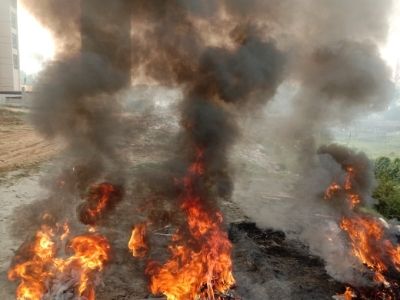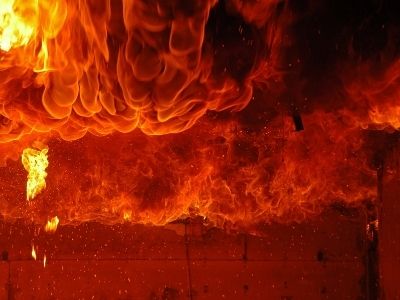When we talk about the dangers of fire, it is usually the flames that come to mind. We fear the ferocity of the blaze and the chance it could burn us and destroy the places and things we love. We don’t always think about smoke as much. Is smoke flammable and, if so, how dangerous is it?

Generally, smoke is flammable but that does not mean it will always ignite. This depends on the type of smoke you and the particles in the smoke. Other environmental conditions could also determine whether or not the smoke catches fire.
These variables and the deeper composition of different types of smoke are why it is so important that we learn more about smoke and its dangers. That is why we are going to look at the following here.
- Why smoke is so dangerous in a fire
- What it is about smoke that makes it flammable
- What a flashover is and how smoke plays its part there
- How the risks vary depending on the type of smoke
- How much you need to worry about candle smoke
Table of Contents
Why is smoke flammable?
There is the assumption that smoke isn’t flammable because it is a byproduct of the fire. The flames burn the flammable materials and turn that into ash and smoke.
But, this isn’t necessarily the case. For a start, not all fires create smoke. It all depends on the material burned. When the combustion of a flammable material is incomplete, smoke is generated.
This is because there isn’t the heat or oxygen needed for the fire to burn properly. Some of those combustible materials end up unburned in the smoke. Under the right, or perhaps more accurately the wrong conditions, that smoke could potentially ignite.
Why is smoke so dangerous?
Smoke is considered to be the most dangerous element in a fire for several reasons. The flammable nature of some forms of smoke is a problem and something that firefighters need to be aware of when assessing a situation.
Nobody wants to do anything that could cause the combustible material in the smoke to spark and spread the fire.
The more well-known risk is that of smoke inhalation and the impact of the smoke on the atmosphere. Smoke inhalation can quickly cause those within a fire to pass out, which is why firefighters have such specialist breathing apparatus with them.

Smoke inhalation is the noted cause of death for civilians in structure fires the majority of the time, rather than burns, impact from explosions, or structural collapse. Smoke is dangerous here for two key reasons.
The first is that you have all those particles in the air that can get into your airways and make you cough and struggle to breathe.
The other is that smoke-filled rooms have a significant amount of both carbon monoxide and carbon dioxide. These can make us sick very quickly.
What is smoke made from?
Smoke is an interesting material because it isn’t one state of matter. There is a good chance that there will be a combination of solid matter, gas, and even some water particles.
It all depends on what material is burning and how complete the burn is. A lot of that smoke will be solid matter in very small particles.
The remaining carbon not burnt turns into soot and rises in the air with other particles of ash and oil. These particles can ignite during a situation of an ongoing fire.
How does smoke catch fire?
As you can see, there are plenty of combustible elements in the wrong kind of smoke that could catch on fire. All a fire needs is a change in conditions for those elements to ignite.
One risk is a change in temperature levels to a high enough point for ignition. This can happen in an enclosed area.
Or, the heat from nearby flames could be enough to make the smoke burst into flames itself. Then there is the risk of adding another fuel source to the flames.
Firefighting relies on reducing oxygen levels so that fires can burn out. An increase in oxygen around the smoke could be enough to fuel the necessary response.
In fact, I made a video breaking down a fire in St. Louis, in this video I show exactly what smoke looks like when it ignites and the dangers of smoke igniting. You can watch the video here:
How dangerous is it if smoke catches fire?
It can be very dangerous if smoke has a chance to catch fire. In some cases, you may get little more than a spark or a short-lived fireball.
But, it is hard to predict where they will occur in a smoke-filled room.
Therefore, there is a risk that these ignitions could start further fires with other flammable materials. The worst incidents are flashovers.
What is a flashover?
Flashover fires are very scary and dangerous phenomenons in structural fires within enclosure areas. A build-up of flammable smoke can penetrate the room and come into contact with all kinds of flammable materials across the room.
Flashover fires happen when everything in a given space reaches a temperature that causes the entire room to ignite at once. This usually happens between 900 to 1,100 degrees Fahrenheit, so firefighters must be aware of conditions and temperatures at all times.

It is an effect you have probably seen in movies from pyrotechnic teams to make scenes more dramatic. The smoke-filled room reaches such a high temperature that the flammable particles in the smoke ignite.
Because of their proximity to other flammable elements in the room, the whole place can go up in seconds.
Do all types of smoke catch fire?
It is important to note that not all types of smoke will catch fire and that some are far more dangerous than others. This is important to know when dealing with a fire, whether as a first responder or a civilian in the vicinity.
White smoke isn’t that big a problem in terms of flammability. You often see fires start with paler smoke as water vapor burns and this smoke doesn’t contain that much in the way of flammable materials.
Some smaller fires or bonfires may stay pale depending on the material burned.
The risk increases when dealing with darker smoke. This is an indicator that there is a greater concentration of combustible materials and therefore a greater risk of the smoke catching fire in the wrong conditions.
The most dangerous smoke is thick black smoke that is dense with soot. You can often see this forming during major incidents at chemical plants or storage facilities.
There is a much higher risk here that the wrong exposure to fuel, heat, and oxygen could the smoke to catch fire.
Is candle smoke dangerous?
This is going to be one of the bigger concerns for anyone learning about the flammable nature of smoke for the first time.
What sort of risk do you face from the smoke created by a candle, either while it burns or when blowing it out?
Rest assured that the risks are minimal here because of the small amount of smoke produced, the likely proximity to a source of ignition, and the fact that not all candle smoke is problematic.
First of all, the biggest risk of flammable candle smoke comes when there are traces of flammable material from the candle in the smoke.
This could be the case when burning synthetic and paraffin candles where a little of the flammable paraffin enters the smoke. Natural candles and beeswax aren’t going to have the same risk.

Then there is the fact that the biggest risk of reignition comes from blowing the candle smoke towards another open flame.
As long as you blow out your candle away from other candles, you should be fine. Even there, there isn’t likely to be more than some pops and flickers due to a lack of flammable material in the smoke.
With that said, there is an irresponsible trend online of a “lifehack” of reigniting candles via candle smoke. Let the smoke disappear and then use a lighter or match where you have more control.
If you are concerned about candle smoke – either as a fire risk or a health risk in your home – you can look for products that are smokeless to reduce the amount released.
Smoke is flammable so be aware of the risks.
To sum things up, smoke can be highly flammable in some cases and safe in others. It all comes down to the combustible materials present in the smoke when the source of the fire starts to burn.
In some cases, there is no immediate threat of accelerating the fire, although there could still be a health risk from inhaling the smoke. In others, there are risks of new fires or flashovers.
The best thing to do is treat all forms of smoke with respect and be aware of the dangers. This means taking care in house fires and when blowing out candles.